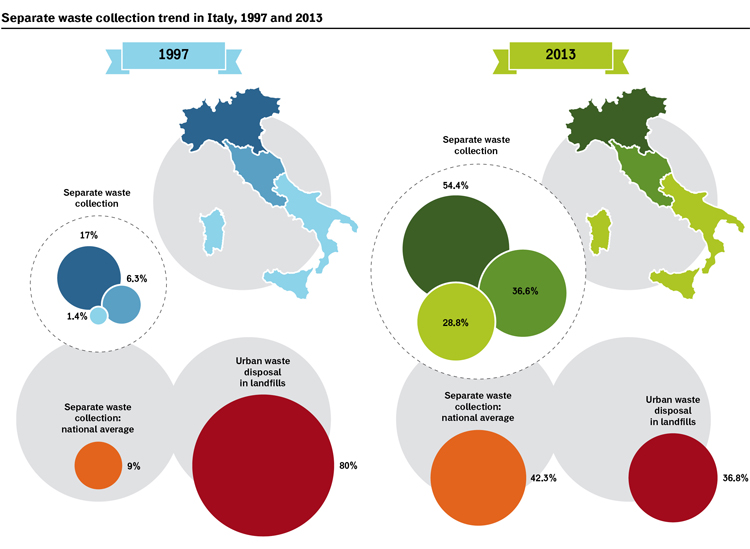In 1997, 80% of Italian urban waste was disposed of in landfills: an amount equal to about 22.3 million tonnes. In the same year, in Italy, the national average separate collection amounted to 9%: 17% in the North, 6.3% in the Centre and 1.4% in the South. Even the most popular fractions of packaging were collected in small amounts: 782.000 tonnes of paper and cardboard, 643.000 tonnes of glass and just 96.000 tonnes of plastic. In 1997, the total amount of separate waste collection came to 2.5 million tonnes. In 1998, its first year of activity, the CONAI chain consortia recovered 3.57 million tonnes of waste from packaging, equal to 34% of packaging placed on the market.
In 2013, the Italian disposal of waste in landfills went down to 36.8%, the quantity also halved compared to 1997; 10.9 million tonnes even if the production of urban waste increased to about 29.6 million tonnes. In 2013, the national average separate collection grew to 42.3%: 54.4% in the North, 36.6% in the Centre and 28.8% in the South. Fractions collected separately have grown considerably: 3.05 million tonnes for paper, 1.6 million tonnes for glass and 945.000 tonnes for plastics. In total, the separate collection of urban waste has risen to 12.5 million tonnes. In 2013, a staggering 7.6 million tonnes of packaging (8 millions in 2014) were recovered and recycled through the CONAI Chain System, amounting to 68% of packaging placed on the market. Basically, since it started, the CONAI System has more than doubled both the percentage and the amount of waste recovered from packaging.

Although not all the problems have been solved, especially in some areas of Southern Italy, these numbers clearly indicate that an important change has taken place in Italy thanks to the waste management reform introduced in 1997: a positive change like very few others in the environment panorama, undoubtedly influenced by the activity of the CONAI Chain Consortia System. It directly contributed to it with about 8 million tonnes of waste from packaging sent to recovery and recycling – the most important waste flow from separate collection – and indirectly because over the years, thanks to its environmental levy, CONAI has supported separate collection at local level.
In my opinion, on the debate about the implementation of producers’ extended responsibility, a basic standard must be borne in mind: a system must be assessed for the results it has produced, it produces and is able to produce. Moreover, we must start from numbers and not from preconceptions. It is impossible not to see that CONAI’s chain consortia have been extremely successful. This system was designed to “achieve global objectives of recovery and recycle and to guarantee a necessary link with the separate collection carried out by municipalities,” reads Legislative Decree 22/1997 that set it up. Obviously, the packaging directive had to be implemented, but I remember very well that when the system was designed, we broadened its scope to include the necessity to significantly increase urban waste recycling and to cut landfill disposal and how to implement and extend to all municipalities separate collection, a non-existent or symbolic reality at that time.
So the CONAI System was designed:
- to guarantee the collection of most selected waste coming from separate collection that would have never been developed if all over Italy municipalities had not been sure to be able to place collected fractions and get paid for them;
- to achieve mandatory European quantity goals on recycling and recovery of packaging, both general and for specific materials;
- to ensure, thanks to a controlled and controllable system, that packaging waste collected through separate collection was effectively sent to recovery and recycling by legal and qualified waste salvagers or recyclers (and did not end up in a landfill or feeding the illegal management in a country where illegality in this sector was widespread and well-known);
- to promote good quality separate collection in order to increase recycling performance and cut the amount of waste to be disposed of;
- to ensure separate collection’s covering of expenses, organized according to efficiency and effectiveness criteria (not encouraging inefficient management), planning, if the return was not enough, to cover the expenses of recovery and recycling and even the delta of these costs by sharing expenses amongst packaging producers and users;
- to organize, and thus fund, awareness campaigns promoting citizens’ participation in the new system.
Obviously, any system can be improved, and this system has not been free from limitations, but if it is assessed taking into consideration its results, we must recognized that it has worked and this is due precisely to its goals and characteristics, clearly spelled out by Legislative Decree 22/1997.
Some maintain that the Italian system is characterized by little competiveness and rather closed to the market. In Italy, there are millions of packaging producers and users: ensuring their effective involvement and reducing to the minimum the risk of environmental levy avoidance were the main objectives. That is why their joining CONAI was made compulsory, valuing its autonomy as an incorporated organization with its own Charter subject to the approval of the Ministry of Environment, and at the time also that of the Ministry of Industry. Once general obligations were defined so that the system could work, we tried, without distorting it, to make it more flexible by establishing that packaging producers could meet their obligations not only by joining one of CONAI’s chain consortia for each type of packaging material (paper, glass, plastic, aluminium, wood and steel) but also by organizing autonomously the management of their packaging waste, or implementing a mandatory deposit and return system.
Another objection: why not multiply chain consortia? More consortia for paper, plastic and glass? It so happens that while there are just a few dozens tyre producers and a few hundred electrical and electronic device manufacturers, there are several millions packaging producers and users: the free and effective access for a multitude of subjects in individual packaging chains would lead to the creation of dozens of consortia (or equivalent organizations). A system with many dozens of chain consortia, competing amongst each other, would be difficult to control and manage, it would increase environmental levy avoidance through the creation of shell consortia, it would destabilize the relation with municipalities and make meeting European targets on recovery and recycling very problematic.
National packaging consortium, www.conai.org.
Legislative Decree 5th February 1997 n. 22, “Implementation of directives 91/156/EEC on waste, 91/689/EEC on hazardous waste and 94/62/CE on packaging and packaging waste,” www.reteambiente.it/normativa/290/.



